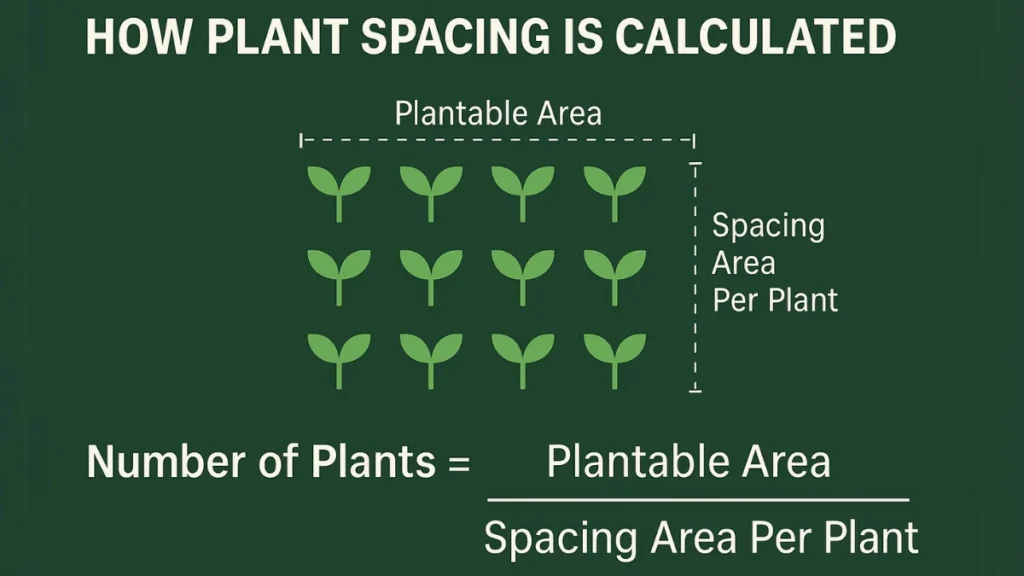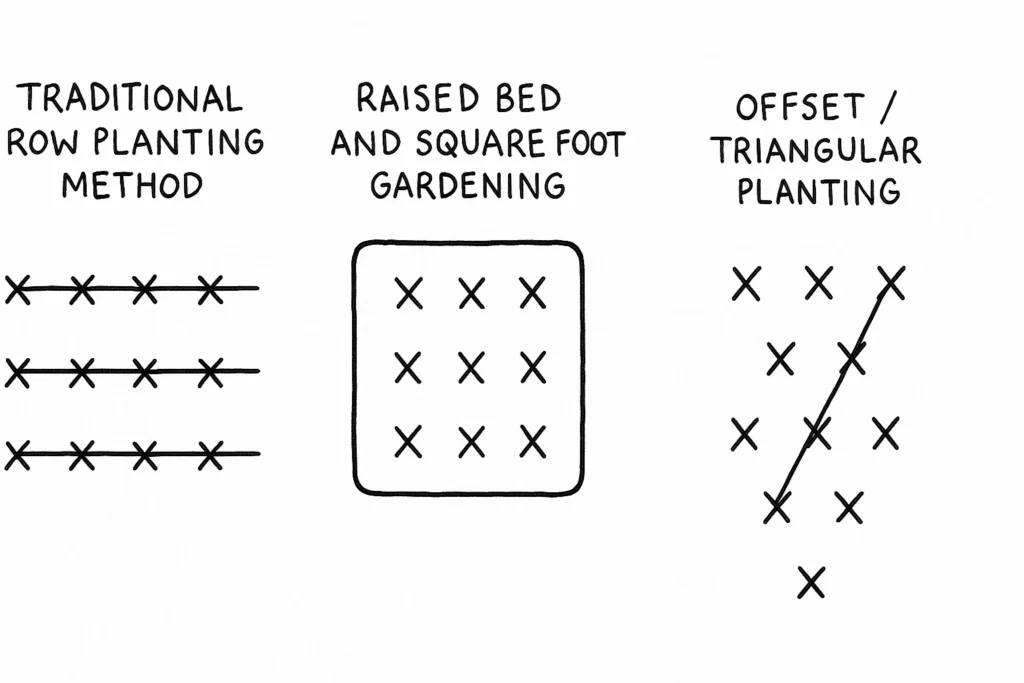🌱 Garden & Plant Spacing Calculator
Recommended companion plants include:
- Carrots & Onions
- Tomatoes & Basil
- Beans & Corn
- Spinach & Strawberries
Garden & Plant Spacing Calculator

Created by James S. Lockwood
With a background in botany and ecological sciences, James specializes in creating practical tools and resources to help gardeners, farmers, and plant enthusiasts optimize their green spaces.
Our plant spacing calculator helps gardeners determine exactly how many plants can fit in a garden bed, container, or acre by using plant spacing formulas. Whether you’re planting vegetables, flowers, or shrubs, proper spacing ensures optimal growth, airflow, and yield.
Table of Contents
Why is Plant Spacing Important?
Proper spacing affects:
Air circulation – prevents mold and mildew
Sunlight exposure – ensures uniform growth
Nutrient competition – keeps each plant strong
Harvest efficiency – easier picking and pruning
The spacing chart used in our calculator ensures you’re not guessing. Whether you’re using a shrub spacing calculator for a hedge or planning spacing in garden rows, these numbers matter.

Plant Spacing Per Square Foot & Container
If you’re doing intensive gardening—like square foot gardening or container growing—the plant spacing calculator is crucial.
Square Foot Gardening:
1 lettuce = 1 sq. ft.
4 beets = 1 sq. ft.
16 carrots = 1 sq. ft.
Container Gardening:
A 5-gallon container can typically fit:
1 tomato plant
2 pepper plants
3–4 bush beans
Use our spacing calculator for plants in containers to avoid overcrowding. It also helps plan your harvest rotation. Proper spacing not only improves yield but also reduces disease pressure by improving airflow — a benefit supported by research on plant density and disease resistance.
How to Use the Plant Spacing Formula?
Most plant spacing calculators rely on this formula:
Plant Spacing Formula (sq ft per plant):
(Plant Spacing in inches ÷ 12) × (Row Spacing in inches ÷ 12)
For example:
A 4×8 bed = 32 sq. ft.
Spacing per tomato = 2.25 sq. ft. (18″ × 18″)
32 ÷ 2.25 = ~14 plants
The formula works for rectangular beds, rows, and containers. Try the triangular plant spacing calculator option if you’re planting in offset patterns for better density.
Raised Beds, Square Foot Gardening, Row Layouts & Triangular Spacing: Which Method Fits Your Space?

The layout you choose—raised beds, square foot gardening, row planting, or offset triangular spacing—will affect not just plant health, but also how many plants you can fit. Our plant spacing calculator makes it easy to toggle between all these formats and find the most efficient design for your garden or plot.
Raised Bed and Square Foot Gardening
Raised beds are ideal for small-space gardeners. These are contained boxes filled with high-quality soil—typically 4×8 feet or smaller. When paired with square foot gardening, spacing becomes even more strategic.
Square Foot Gardening divides the bed into 1×1 ft sections.
Each square is planted based on mature plant size. For example:
1 tomato per square
4 lettuce heads per square
9 spinach plants per square
16 carrots per square
This method drastically increases yield per foot. The plant spacing calculator adjusts for this density—especially when you want to calculate how many plants can fit in a raised bed.
✅ Try the Raised Garden Bed Calculator to plan your next raised bed layout.
Traditional Row Planting Method
Row planting is the go-to strategy for field-scale growers and classic vegetable gardens. Plants are spaced at set intervals within rows, with walking space between rows for easy access.
Why rows work:
Efficient for crops that need vertical support (e.g., beans, corn, tomatoes)
Easier to irrigate and weed
Maximizes air circulation
Typical spacing:
Beans: 4–6″ apart in 18–24″ rows
Corn: 12″ apart in 30″ rows
Tomatoes: 18–36″ apart in 24–36″ rows
The plant spacing calculator factors in both in-row and between-row distances so you get a realistic count of how many plants will actually fit.
Offset / Triangular Planting (Irregular)
For gardeners looking to maximize plant count without crowding, triangular or offset spacing is ideal. This method places each row’s plants between the gaps of the previous row, creating a hexagonal grid that fits more plants into the same space.
Perfect for dense groundcovers, flowers, and herb gardens
Allows more airflow than square spacing
Boosts coverage efficiency by up to 15%
To plan this layout, choose the “irregular” layout option in our plant spacing calculator, which automatically adjusts calculations based on triangular geometry.
✅ Need precision? Use our Triangular Plant Spacing Calculator and watch your space efficiency soar.
By combining layout planning with the right plant spacing formula, you reduce overcrowding, boost productivity, and make garden maintenance easier. Whether you’re planting lettuce in raised beds, corn in rows, or lavender in offset rows, using the spacing calculator for plants helps you do it right the first time.
Plant Spacing Per Acre
If you’re planting larger plots or field crops, switch the plant spacing calculator to per-acre mode. Here’s a quick example:
Corn: 30″ rows, 6″ plant spacing
Plants per acre = 43,560 sq. ft. ÷ (2.5 ft × 0.5 ft) = ~34,848 plants
This precision makes a difference in crop yield and cost-efficiency—especially when calculating large-scale investments.
✅ Before planting hundreds of shrubs or rows of trees, check your layout with our Plant Spacing Calculator here.
Spacing Garden Rows: Best Practices
Spacing between rows matters just as much as spacing between plants. Overcrowded rows make weeding and harvesting difficult. General row spacing guidelines:
| Crop Type | Row Spacing |
|---|---|
| Root Vegetables | 12–18″ |
| Leafy Greens | 8–12″ |
| Tall Plants (Corn, Tomatoes) | 24–36″ |
| Bush Beans & Peas | 18–24″ |
Use a garden spacing calculator to integrate both in-row and between-row spacing. That’s how you calculate how many plants per row and bed accurately.
Plant Spacing Chart for Common Crops
The table below provides general spacing recommendations for popular garden crops. Use these as a guideline when planning your garden layout.
Tomatoes 🍅
🌱 18 - 24 inches Plant Spacing
🌿 36 - 48 inches Row Spacing
Carrots 🥕
🌱 2 - 3 inches Plant Spacing
🌿 12 - 18 inches Row Spacing
Lettuce 🥬
🌱 6 - 12 inches Plant Spacing
🌿 12 - 18 inches Row Spacing
Broccoli 🥦
🌱 18 - 24 inches Plant Spacing
🌿 24 - 36 inches Row Spacing
Peppers 🌶️
🌱 12 - 18 inches Plant Spacing
🌿 24 - 36 inches Row Spacing
Cabbage 🥬
🌱 18 - 24 inches Plant Spacing
🌿 24 - 36 inches Row Spacing
Corn 🌽
🌱 12 - 18 inches Plant Spacing
🌿 30 - 36 inches Row Spacing
Beans (Bush) 🫘
🌱 4 - 6 inches Plant Spacing
🌿 18 - 24 inches Row Spacing
Beans (Pole) 🫘
🌱 6 - 12 inches Plant Spacing
🌿 24 - 36 inches Row Spacing
Cucumbers 🥒
🌱 12 - 24 inches Plant Spacing
🌿 36 - 48 inches Row Spacing
Zucchini 🎃
🌱 24 - 36 inches Plant Spacing
🌿 36 - 48 inches Row Spacing
Strawberries 🍓
🌱 12 - 18 inches Plant Spacing
🌿 18 - 24 inches Row Spacing
Basil 🌿
🌱 6 - 12 inches Plant Spacing
🌿 12 - 18 inches Row Spacing
Mint 🍃
🌱 12 - 18 inches Plant Spacing
🌿 18 - 24 inches Row Spacing
These figures feed directly into the plant spacing calculator, helping you quickly calculate how many plants you’ll need based on available space.
For field crops like corn, check our dedicated corn spacing calculator for precision results.
How to Calculate Plant Population by Spacing?
Plant population refers to the total number of plants that can grow in a defined area based on the spacing between plants and rows.
Standard Formula
Plant Population = (Area of Field or Garden) ÷ (Row Spacing × Plant Spacing)
✅ Make sure spacing values are in feet for acres or inches for square feet.
Example Calculation (in square feet)
Garden size: 100 sq ft
Plant spacing: 12 inches
Row spacing: 12 inches
Each plant needs 1 sq ft (12″ × 12″), so:
100 sq ft ÷ 1 sq ft per plant = 100 plantsField Crop Example (Acres)
Field size: 1 acre = 43,560 sq ft
Plant spacing: 6 inches (0.5 ft)
Row spacing: 30 inches (2.5 ft)
Plant Population = 43,560 ÷ (0.5 × 2.5) = 34,848 plants per acre
Use the Plant Population Calculator for quick results with precision.
Triangular Plant Spacing (Offset Layout)
Offset or high-density patterns increase plant counts by up to 15% using the formula:
Adjusted Population = Standard Plant Count × 1.15Try this option in plant spacing calculator under “Offset Planting” for maximum space utilization.
How to Use Plant Spacing Calculator?
Choose the plant type or enter custom spacing.
Enter bed/container dimensions in feet.
Select row spacing or triangular layout if applicable.
Get your results: number of plants + layout tips.
Whether using it as a shrub spacing calculator or planning per container, this tool adapts to every setup.
✅ Want to know how much your tree or plant investment might cost? Check out our Tree Planting Cost Calculator.
How Many Plants Do I Need?
Knowing how many plants to buy or start from seed depends on a few key factors:
✅ 1. Measure Your Planting Area
Use square feet, square meters, or acres to define your planting area.
Example: A 10ft × 10ft garden bed = 100 sq ft.
✅ 2. Choose Plant Spacing
Spacing depends on the type of plant:
Lettuce: 6″ spacing → ~4 plants/sq ft
Tomatoes: 24″ spacing → ~0.25 plants/sq ft
Shrubs/Perennials: Typically 18–60 inches apart
📌 Formula:
Plants Needed = Planting Area (sq ft) / Area Required Per Plant
You can also use our Plant Spacing Calculator to automate this.
Example Calculation
If you’re planting:
In 100 sq ft
Using 12″ x 12″ spacing (1 sq ft per plant)
👉 You need 100 plants
🌻 How Many Perennials Per Square Foot?
Spacing perennials varies (typically 1–2 per sq ft). Use our calculator or follow spacing labels on nursery pots.
🌿 How Many Shrubs Do I Need?
For shrubs spaced 3 feet apart:
1 plant per 9 sq ft → 100 sq ft ÷ 9 = ~11 shrubs
🌾 Plants Per Square Meter
Convert area:
1 sq meter = 10.764 sq ft
100 sq ft = 9.29 sq meters
✅ Use our Plant Spacing Calculator to quickly determine how many plants you need.
How to Calculate Plant Utilization?
Plant utilization measures how efficiently you’re using your available garden space based on plant spacing and layout. It tells you the percentage of area that’s actually planted versus what’s left as walking paths or gaps.
Formula for Plant Utilization:
Plant Utilization (%) = (Total Plant Area ÷ Total Bed Area) × 100
Where:
Total Plant Area = Number of plants × Spacing area per plant (sq. ft.)
Total Bed Area = Length × Width of the garden or raised bed
Example:
You’re planting 16 lettuces spaced 10″ apart (≈0.7 ft spacing), in a 4×4 ft raised bed (16 sq. ft).
Spacing area per plant = 0.7 ft × 0.7 ft = 0.49 sq. ft
Total Plant Area = 16 × 0.49 = 7.84 sq. ft
Bed Area = 16 sq. ft
Plant Utilization = (7.84 ÷ 16) × 100 = 49%
This means only 49% of your raised bed is actively growing plants. To improve this, consider switching to triangular planting using the “irregular” layout option in the plant spacing calculator, which increases efficiency.
FAQs: Garden and Plant Spacing Calculator
❓ What is a plant spacing calculator?
A plant spacing calculator is a tool that tells you how many plants fit in your garden bed or container based on species-specific spacing.
❓ How many plants per square foot?
It depends on the plant: lettuce = 1, carrots = up to 16. Use our garden spacing calculator to get it exact.
❓ Is triangular spacing better?
Triangular patterns use space more efficiently, especially for groundcovers or high-density plantings. Use the triangular plant spacing calculator setting to try it.
❓ How do I calculate plant spacing per container?
Input your pot size and desired spacing into the spacing calculator for plants, and it’ll tell you how many will thrive.
❓ Can I use the spacing chart for per-acre calculations?
Yes. The plant spacing per acre feature adjusts plant totals based on your crop and layout style.
Disclaimer for Plant Spacing Calculator
This Plant Spacing Calculator provides estimated plant counts based on user inputs and general spacing guidelines. Actual results may vary due to soil conditions, climate, plant species, and growth habits. Always refer to expert recommendations or local agricultural guidelines for precise planting strategies. We are not responsible for any outcomes resulting from the use of this tool.
Discover Crop & Farming Calculators
